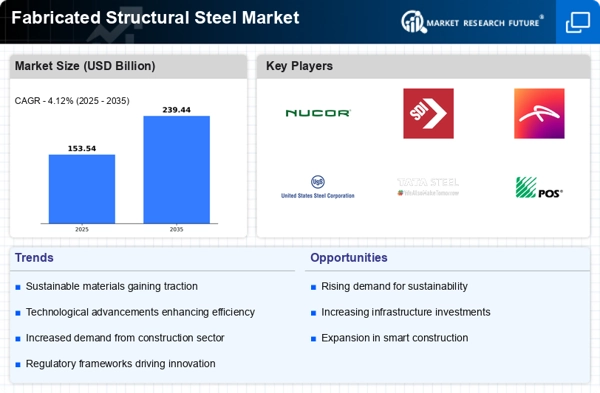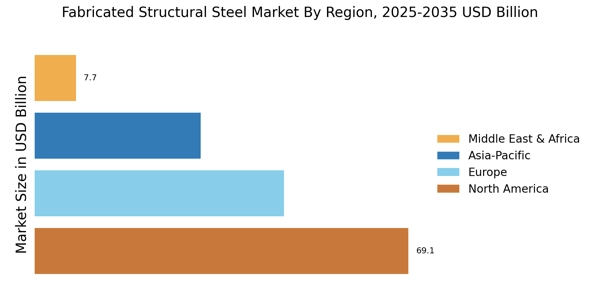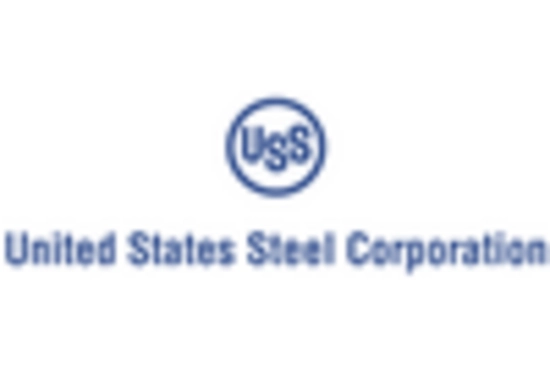Global Trade Dynamics
The dynamics of The Fabricated Structural Steel Industry in various ways. Trade agreements and tariffs can affect the availability and pricing of raw materials essential for steel fabrication. In 2025, fluctuations in trade policies may lead to increased costs or supply chain disruptions, impacting the overall market landscape. However, the demand for fabricated structural steel remains resilient, as countries continue to invest in infrastructure and construction projects. The ability to adapt to changing trade conditions will be crucial for manufacturers in this sector. Moreover, the expansion of international markets presents opportunities for growth, as emerging economies ramp up their construction activities, thereby increasing the demand for fabricated structural steel.
Infrastructure Development
The ongoing expansion of infrastructure projects worldwide is a primary driver for the Fabricated Structural Steel Market. Governments and private sectors are investing heavily in transportation networks, bridges, and commercial buildings. For instance, the construction of new highways and railways necessitates the use of fabricated structural steel due to its strength and durability. In 2025, the demand for fabricated structural steel is projected to rise by approximately 5% annually, driven by these infrastructure initiatives. This trend indicates a robust market environment, as the need for reliable and efficient construction materials becomes increasingly critical. Furthermore, urbanization trends contribute to this demand, as cities expand and require more complex structures, thereby enhancing the role of fabricated structural steel in modern construction.
Sustainability Regulations
Increasingly stringent sustainability regulations are shaping the Fabricated Structural Steel Market. Governments are implementing policies that promote the use of eco-friendly materials and practices in construction. Fabricated structural steel, known for its recyclability and lower carbon footprint compared to traditional materials, is becoming a preferred choice for environmentally conscious builders. In 2025, it is anticipated that projects adhering to green building standards will account for over 30% of new constructions, thereby driving demand for sustainable materials. This shift not only aligns with global sustainability goals but also positions the fabricated structural steel sector as a leader in responsible construction practices. The emphasis on sustainability is likely to attract investments and foster innovation within the industry.
Technological Advancements
Technological innovations in the fabrication process are significantly influencing the Fabricated Structural Steel Market. Advanced manufacturing techniques, such as automated welding and 3D modeling, enhance precision and reduce waste, making the production of structural steel more efficient. The integration of Building Information Modeling (BIM) allows for better project visualization and coordination, which is essential in large-scale construction projects. As of 2025, it is estimated that the adoption of these technologies could lead to a 10% reduction in production costs, thereby making fabricated structural steel more competitive against alternative materials. This technological evolution not only improves the quality of the final product but also streamlines the supply chain, further solidifying the market's growth trajectory.
Rising Construction Activities
The resurgence of construction activities across various sectors is a significant driver for the Fabricated Structural Steel Market. With the recovery of the real estate market and increased spending on commercial and residential projects, the demand for fabricated structural steel is expected to surge. In 2025, the construction sector is projected to grow by approximately 4% annually, with fabricated structural steel playing a crucial role in meeting the structural demands of new buildings. This growth is further supported by the trend towards high-rise buildings and complex architectural designs, which require the strength and versatility that fabricated structural steel offers. As construction activities ramp up, the market is likely to experience heightened competition among suppliers, leading to innovations and improved service offerings.


















Leave a Comment